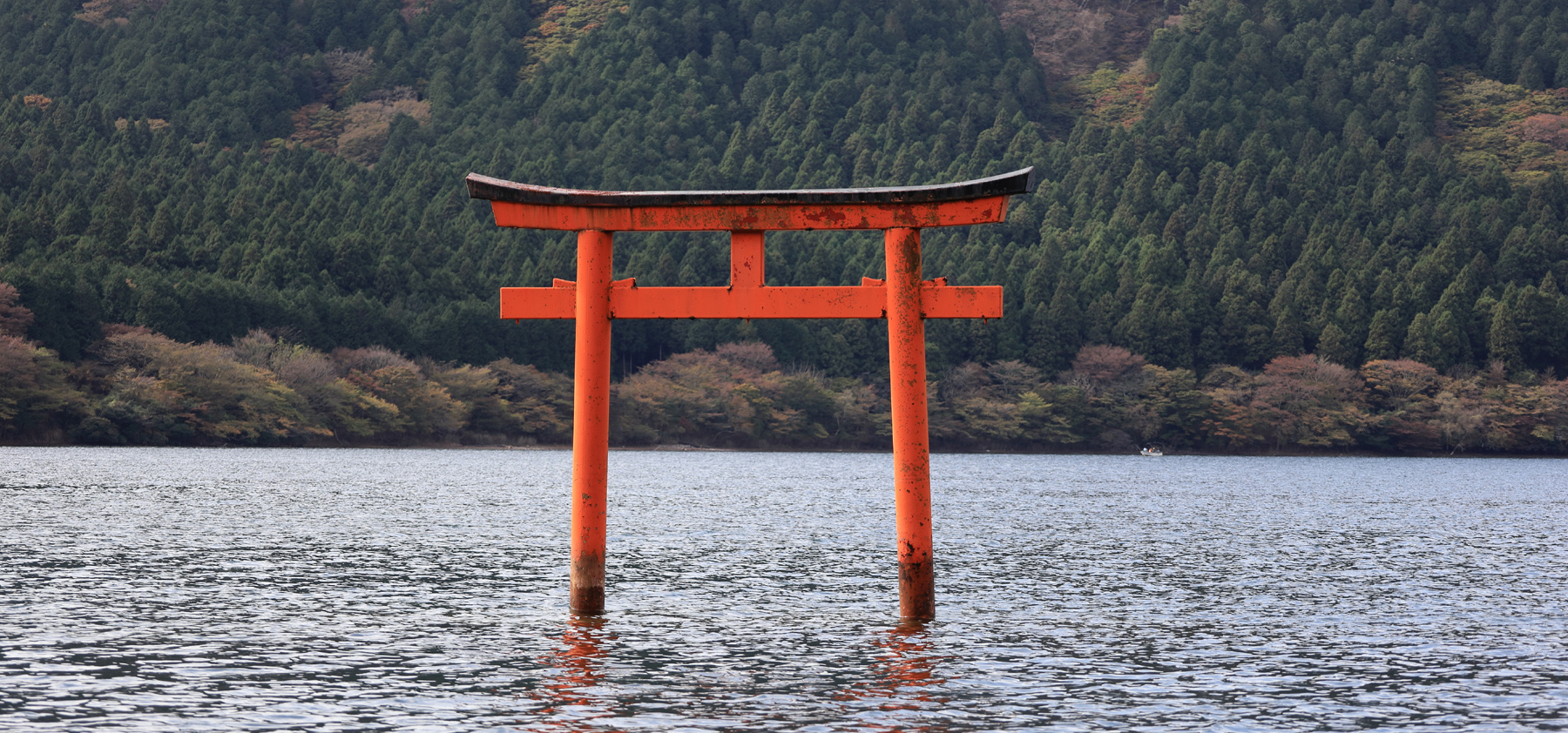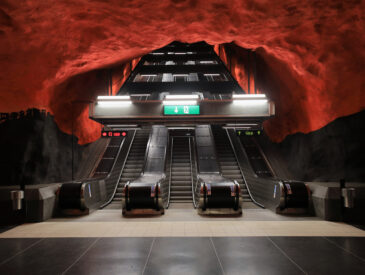About 50 miles from Tokyo, Hakone has many iconic attractions, from an active volcano – still venting sulphurous fumes – to lakeside forest shrines with floating torii gates. Exploring them involves a variety of modes of transport; throw in the chance of views of Mt. Fuji and an unusual local delicacy, and I was intrigued!
This side trip was a late addition to my Japan plan, which originally focused almost entirely on Tokyo. But a flight cancellation gave me an extra 24 hours to play with, and in retrospect I’m glad I spent them on an excursion beyond the city. The Hakone loop seems to be a popular day tour, but I took a more leisurely approach – building in an overnight stay so I could try the bulk of the circuit in each direction, rather than completing a single lap by bus.
Logistics and travel from Tokyo

I purchased a two day Hakone Free Pass – covering the return trip from Tokyo, and all local forms of transport – at the dedicated tourist office in Shinjuku station. The pass was ¥6100 (about £30), but I considered it well worth adding an extra ¥1200 each way to upgrade from a regional service to the ‘Romance Car’.
This cuts the journey time down from a couple of hours to 80 minutes, and trades a metro-like experience for a much more comfortable train. Its curious name comes from seating being in sofa-like pairs with no separating arm-rest; fortunately I didn’t have to cosy up with a stranger! In an impressive bit of choreography, all the seats rotated into a forward-facing configuration at Shinjuku. I had been assigned a spot by one of the huge windows, and was pleased to find plenty of legroom, almost excessive recline, and at-seat power.
A third option is to take a Shinkansen to Odawara, then join either of the above services; there’s a cheaper Hakone pass available for this shorter itinerary. The section from Odawara to Hakone is the most scenic, with views of the Kamagawa mountains, so it might be worth speeding through the initial stretch if you’ve got a JR rail pass (or are travelling from somewhere other than Tokyo).
I had stashed my luggage in a locker at the metro stop near my AirBnB in Tokyo, which was definitely the right move. It would have been a severe hindrance on most stages of the loop, and although there turned out to be lockers at the arrival point of Hakone-Yumoto station, they are more expensive and you’re gambling on there still being space. Shinjuku is another option, but it’s such a maze I feared I would never find my storage spot again!
Hakone Tozan Train to Gora

At Hakone-Yumoto I took the counter-clockwise route, continuing by train. There seem to be a few types of rolling stock – I boarded a modern 3000-series with almost floor-to-ceiling windows. Amusingly, what little wall space remained carried adverts for the Bernina Express – I wonder how many people have travelled on both?
In less than 9 kilometres the train climbs 450 metres; on the steepest sections (up to 8% gradient) there is a 3.6m height difference between the front and rear cabs! Three switchbacks, 2km of tunnels, and several stations also feature on this century-old single-track route, which takes 35 minutes to meander through mountain forests.
As well as admiring the scenery, a glass wall between passenger and driver compartments meant I could witness the Japanese practice of ‘pointing and calling’. There is also narration (in English) which describes some of the sights rolling by, and is how I learnt most of the facts above.
Hakone Tozan Cable Car to Sounzan

I found the naming of Hakone’s various modes of transport confusing – the area does have what I would call cable cars, but here those are described as a ropeway. The Tozan Cable Car, instead, is a funicular railway: gaining another 214m of altitude in little over a kilometre of run.
Unfortunately, whilst technically impressive, it’s not a great experience. On both my ascent and descent, the train was rammed full of passengers in a fashion more akin to commuting on the metro than leisurely sight-seeing. Fortunately the journey only takes ten minutes to reach Sounzan, where I was able to pause to admire the landscape: although don’t expect fresh mountain air, as there was already a hint of sulphur…
Hakone Ropeway and Owakudani

At Sounzan there are stark warnings that anyone with asthma, respiratory / heart diseases or an alarmingly vague “health problems” should proceed no further – for the gondolas travel directly over the volcano and its active fumaroles. I take my chances, and the views are as staggering as the smell! It’s more industrial that I expected – hot water is channelled from the springs to feed spas, and I think some sort of mining goes on too. It’s incredible to think this volcano has continued to smoulder away since its last eruption thousands of years ago.
The ropeway operates in two sections, with a changeover at Owakudani, the station marking the high point of the Hakone loop at over a kilometre above sea level. There are also extensive tourist facilities here; the peak is also accessible by bus. Some hiking trails are closed, and tours are apparently only available to those who can understand the – Japanese only – safety briefing.
But I was here on a very specific quest: to eat an egg hard-boiled in the heat of the volcanic springs. The sulphur content of the water imparts both a distinctive aroma, and a pitch black colour, to these kuro-tamago. Since the whole crater stinks of rotting eggs, consuming one would surely be a trial – but endure it, and you supposedly will be rewarded with an additional seven years of life.
Tragically, what I purchased from the station gift shop was not what I had been seeking – true black eggs can only be eaten there and then at the peak. The ones I acquired had a longer shelf life, but would do nothing to extend mine: these smoked and seasoned eggs were created in a factory, not a volcano! Despite two visits to Owakudani, explaining the whole concept to another traveller, noting mine were more of a brown colour, and even a selfie alongside a statue of a black egg, I somehow failed to realise my mistake until several days later – and a few thousand miles away – back in Helsinki. Someday I hope to try again…

Hakone Sightseeing Cruise and Lake Ashi

Completing the Hakone loop requires keeping a fairly tight schedule – although the ropeway down to Togendai operates until 16:45, the last ships are at 16:25 and 17:00. I made it in time for the earlier of those, which at this time of year meant I was able to enjoy a sunset cruise. Lake Ashi itself was beautiful, the mountain slopes leading to its shores covered in forests beginning to turn to autumn colours. There are two floating torii gates to the east, each associated to a shrine; and if conditions are right, Mt Fuji is visible to the north (I only saw it during the evening).
The ships are styled like pirate galleons; upgrading to first class apparently gets you better seating, but the standard ticket still gives you access to part of the open-air top deck, which is where I happily spent my time on both crossings. It’s worth paying attention to which of the two southern ports (Motohakone-ko and Hakonemachi-ko) the ship will be calling first – or if it’s even serving both, as the final Togendai departure does not! Also note that there is another company – using modern ferries – that serves some other points around the lake, but is not covered by the Hakone free pass.
Motohakone and the Hakone Shrine
One look at the queue for buses back to Hakone-Yumoto and it was clear I had made the right choice by adding an overnight stay instead of completing the loop by road. This was doubly-reinforced the next morning; my otherwise basic room at a tiny lakeside inn had a balcony, where I was able to enjoy both the views and a decadent breakfast of limited-edition cheesecake (obtained from a specialised vending machine!)

Starting local also allowed me to set out before 8am and beat most of the sightseeing crowds at Hakone shrine, a few minutes walk from my accommodation. I say most as there were already half a dozen people politely queueing for selfies at the main attraction, Heiwa no Torii (Torii of Peace). I can only imagine the wait is much worse once buses and boats start to arrive, as it seems the fashion these days is for not just a photo but a time-consuming video.
Although the floating torii is the highlight, there are plenty of other striking sights – the bright red paint applied to wooden structures sets them in stark contrast to the surrounding woodland. After breakfast I also spent some time down by the lakeside, watching the comings and goings of smaller watercraft until my return ship arrived.
Forest bathing and Kuzuryū Shrine

On reaching Togendai I left the loop and made my way around from the pirate ship docks to the ferry terminal. There I joined a ‘therapy road’ – a path dedicated to the Japanese concept of Shinrin-yoku, forest bathing. This trail winds for two miles through forests (of both trees and bamboo) above lake Ashi, before arriving at another shrine, Kuzuryū. For this there is a modest extra charge, but it’s both a larger site than Hakone shrine and – despite having another floating torii – seemingly less-visited. You can easily get to the shore of the lake, which proved a pleasant spot for a picnic of smoked eggs.
I completed the walk out and back in a leisurely two hours, and in that time I only encountered two other people on the trail. I’m glad I took this detour from the loop – although it’s a shame I didn’t find time for another local attraction, the Hakone Open Air Museum. Even omitting that, it felt like a bit of a rush to get back to Tokyo in a sensible time. I went from ropeway to cable car to Tozan train as fast as the schedules would allow, but it still took nearly two hours to retrace my steps from the peak of Owakudani to Hakone-Yumoto station.
As a result I’m not sure I would recommend my there-and-back-again itinerary unless you’re a serious transport geek: the traditional loop is probably the sensible way to explore Hakone after all… I would however strongly suggest including an overnight stop rather than trying to squeeze everything into a daytrip. Hopefully someday I will return for a proper kuro-tamago, and can do so as part of another extended visit!
You can find plenty more photos from Hakone – particularly the shrines – in the next post.




